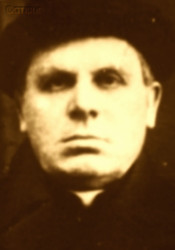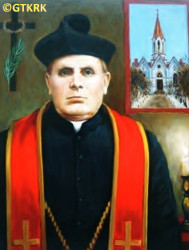Roman Catholic
St Sigismund parish
05-507 Słomczyn
85 Wiślana Str.
Konstancin deanery
Warsaw archdiocese, Poland
full list:
displayClick to display full list

searchClick to search full list by categories
wyświetlKliknij by wyświetlić pełną listę po polsku

szukajKliknij by przeszukać listę wg kategorii po polsku

Martyrology of the clergy — Poland
XX century (1914 – 1989)
personal data
religious status
Servant of God
surname
CZERWIŃSKI
forename(s)
Anthony (pl. Antoni)
function
diocesan priest
creed
Latin (Roman Catholic) Church RCmore on
en.wikipedia.org
[access: 2014.09.21]
diocese / province
Tiraspol diocesemore on
en.wikipedia.org
[access: 2014.11.14]
academic distinctions
Sacred Theology MA
date and place
of death
26.01.1938

Vladikavkaztoday: Vladikavkaz city reg., North Ossetia‐Alania rep., Russia
more on
en.wikipedia.org
[access: 2022.07.21]
alt. dates and places
of death
16‑17.01.1938
details of death
Arrested by Russians on 02.12.1936 in Vladikavkaz together with two other priests, Fr John Roth (Volga German) and Fr Boleslav Blechman, his sister, the organist, f. church guard and few women parishioners, Poles and Russians.
On 15.12.1936 formally accused of „founding and leading of counter–revolutionary, fascist and nationalist group” and „organizing counter–revolutionary movement among Poles living in Ordzhonikidze (Vladikavkaz)”.
After almost a year of interrogations in prison, where he lost his sight, on 01‐02.11.1937 sentenced to death.
Murdered in the prison.
cause of death
murder
perpetrators
Russians
sites and events
11.08.1937 Russian genocideClick to display the description, Great Purge 1937Click to display the description
date and place
of birth
08.10.1881

Biłgorajtoday: Biłgoraj urban gm., Biłgoraj pov., Lublin voiv., Poland
more on
en.wikipedia.org
[access: 2020.12.03]
presbyter (holy orders)
ordination
1905

positions held
from 1911
parish priest — Vladikavkaztoday: Vladikavkaz city reg., North Ossetia‐Alania rep., Russia
more on
en.wikipedia.org
[access: 2022.07.21] ⋄ RC parish ⋄ Pyatigorsktoday: Pyatigorsk reg., Stavropol Krai, Russia
more on
en.wikipedia.org
[access: 2022.07.16] RC deanery — prefect at gymnasium for boys and girls, also serving in the orphaned Georgian parishes of Mozdok, Groźny, Chasow–Yurt, Chutor Miński (until 1932) and Bujnaksk in Dagestan
secretary — personal, to Bishop Joseph Kessler ⋄ Tiraspol RC diocese
prefect — Nikolayevsktoday: Nikolayevsk urban, Nikolayevsk reg., Vologda oblast, Russia
more on
en.wikipedia.org
[access: 2022.08.05] ⋄ Saratovtoday: Saratov oblast, Russia
more on
en.wikipedia.org
[access: 2022.02.04] RC deanery
vicar — Saratovtoday: Saratov oblast, Russia
more on
en.wikipedia.org
[access: 2022.02.04] ⋄ St Clement RC cathedral parish
till c. 1905
student — Sankt Petersburgtoday: Saint Petersburg city, Russia
more on
en.wikipedia.org
[access: 2020.07.31] ⋄ philosophy and theology, Imperial Roman Catholic Spiritual Academy (1842‐1918) — postgraduate specialised studies crowned with a Sacred Theology Master's degree
till c. 1904
student — Saratovtoday: Saratov oblast, Russia
more on
en.wikipedia.org
[access: 2022.02.04] ⋄ philosophy and theology, Theological Seminary
others related
in death
BLECHMANClick to display biography Boleslav
sites and events
descriptions
11.08.1937 Russian genocide: On 11.08.1937 Russian leader Stalin decided and NKVD head, Nicholas Jeżow, signed a «Polish operation» executive order no 00485. 139,835 Poles living in Russia were thus sentenced summarily to death. According to the records of the „Memorial” International Association for Historical, Educational, Charitable and Defense of Human Rights (Rus. Международное историко‐просветительское, правозащитное и благотворительное общество „Мемориал”), specialising with historical research and promoting knowledge about the victims of Russian repressions — 111,091 were murdered. 28,744 were sentenced to deportation to concentration camps in Gulag. Altogether however more than 100,000 Poles were deported, mainly to Kazakhstan, Siberia, Kharkov and Dniepropetrovsk. According to some historians, the number of victims should be multiplied by at least two, because not only the named persons were murdered, but entire Polish families (the mere suspicion of Polish nationality was sufficient). Taking into account the fact that the given number does not include the genocide in eastern Russia (Siberia), the number of victims may be as high as 500,000 Poles. (more on: en.wikipedia.orgClick to attempt to display webpage
[access: 2016.03.14])
Great Purge 1937: „Great Terror” (also «Great Purge», also called „Yezhovshchyna” after the name of the then head of the NKVD) — a Russian state action of political terror, planned and directed against millions of innocent victims — national minorities, wealthier peasants (kulaks), people considered opponents political, army officers, the greatest intensity of which took place from 09.1936 to 08.1938. It reached its peak starting in the summer of 1937, when Art. 58‐14 of the Penal Code about „counter‐revolutionary sabotage” was passed , which became the basis for the „legalization” of murders, and on 02.07.1937 when the highest authorities of Russia, under the leadership of Joseph Stalin, issued a decree on the initiation of action against the kulaks. Next a number of executive orders of the NKVD followed, including No. 00439 of 25.07.1937, starting the liquidation of 25,000‐42,000 Germans living in Russia (mainly the so‐called Volga Germans); No. 00447 of 30.07.1937, beginning the liquidation of „anti‐Russian elements”, and No. 00485[2] of 11.08.1937, ordering the murder of 139,835 people of Polish nationality (the latter was the largest operation of this type — encompassed 12.5% of all those murdered during the «Great Purge», while Poles constituted 0.4% of the population). In the summer of 1937 Polish Catholic priests held in Solovetsky Islands, Anzer Island and ITL BelbaltLag were locked in prison cells (some in Sankt Petersburg). Next in a few kangaroo, murderous Russian trials (on 09.10.1937, 25.11.1937, among others) run by so‐called «NKVD Troika» all were sentenced to death. They were subsequently executed by a single shot to the back of the head. The murders took place either in Sankt Petersburg prison or directly in places of mass murder, e.g. Sandarmokh or Levashov Wilderness, where their bodies were dumped into the ditches. Other priests were arrested in the places they still ministered in and next murdered in local NKVD headquarters (e.g. in Minsk in Belarus), after equally genocidal trials run by aforementioned «NKVD Troika» kangaroo courts.
sources
personal:
biographies.library.nd.eduClick to attempt to display webpage
[access: 2014.12.20], pl.catholicmartyrs.orgClick to attempt to display webpage
[access: 2014.12.20], archive.todayClick to attempt to display webpage
[access: 2014.05.09]
bibliographical:
„Fate of the Catholic clergy in USSR 1917‐1939. Martyrology”, Roman Dzwonkowski, SAC, ed. Science Society KUL, 2003, Lublin
original images:
pl.catholicmartyrs.orgClick to attempt to display webpage
[access: 2014.12.20], krzysztofpozarski.files.wordpress.comClick to attempt to display webpage
[access: 2019.04.16], ipn.gov.plClick to attempt to display webpage
[access: 2019.02.02]
LETTER to CUSTODIAN/ADMINISTRATOR
If you have an Email client on your communicator/computer — such as Mozilla Thunderbird, Windows Mail or Microsoft Outlook, described at WikipediaPatrz:
en.wikipedia.org, among others — try the link below, please:
LETTER to CUSTODIAN/ADMINISTRATORClick and try to call your own Email client
If however you do not run such a client or the above link is not active please send an email to the Custodian/Administrator using your account — in your customary email/correspondence engine — at the following address:

giving the following as the subject:
MARTYROLOGY: CZERWIŃSKI Anthony
To return to the biography press below:
 Click to return to biography
Click to return to biography










